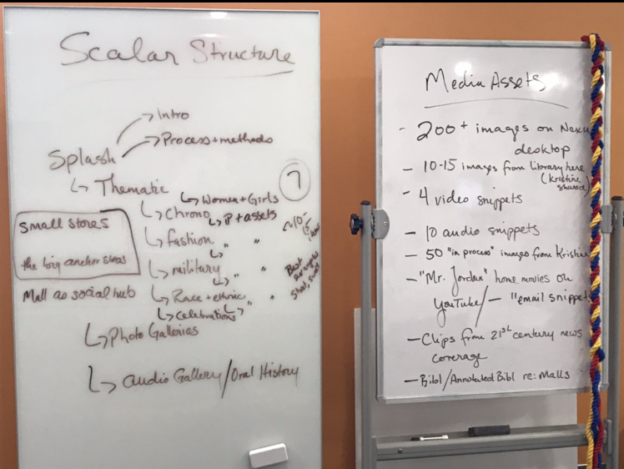Last week the Park Central Mall team members and I got together to discuss the next step in the project, which is the creation of a multimedia presentation of the interesting photos, articles, and oral histories that were curated after sifting through the 18 scrapbooks found in the mall basement. After conversing with Dr. Matthew Delmont, Dr. Jacqueline Wernimont, Elizabeth Grumbach, and Dr. Kristine Navarro, we came to important conclusions regarding the structure of what the multimedia Scalar presentation would look like, as well as deadlines for the workflow.
The domain name has been purchased for the Scalar site, and the landing page or “splash page” already exists. On this page we will write an introduction to the project, which includes the mall’s history. We have established some thematic pathways including: space race, ethnic events, fashion, military, the mall as social hub, and gender. Included with each theme will be a relatively short paragraph to introduce each collection regarding the appropriate taxonomy. Finally, 10-15 images will be included which best encompass each individual theme.
Apart from the thematic content pathways, we will include: photo galleries (making the top 10 best items we found pop), a section dedicated to the stores at the mall, the process (work flow, methodology, and collaboration of the project), memories section (audio and video interviews of patrons of the mall), and weaving in short memory quotes from interviewees into thematic pathways or do something visually appealing with the quotes.
The collection of scrapbooks will soon be shipped off and stored in ASU’s library at the Polytech campus, so the remaining photos that were taken this week were of blue prints of the mall’s exterior that will be used as background images to the Scalar page.
We then discussed the quantity and type of media assets that we have acquired thus far for the project. While oral histories are still being recorded, the next collection event being April 7th, we anticipate to be able to include: 4 edited video and 10 audio clips, 200+ images, 10-15 images found by Dr. Navarro, home movie clips on Youtube provided by interviewees along with some of their brief quotes, Clips from 21st century news coverage, and the contextual research about malls in the next two months.
Our last discussion point to cover was “Where to jump in and start?” I will be starting to get media items up on the page, by uploading the photos discovered within the scrapbooks one by one. I will be learning how to use Scalar, relying on an available construction guide and tutorial videos on Youtube, unless of course I hit a snag (in which case I will speak with Elizabeth, Dr. Wernimont, and Dr. Delmont).
We will develop a controlled vocabulary for tagging, and share this amongst our team, as several individuals will have author privileges for the Scalar account. Scalar has the ability to use Dublin Core and perhaps Library of Congress. We will decide amongst ourselves and pick one to use for the tagging of media content.
Regarding the videos interviews, there seems to be a preference for the Vimeo platform. A positive aspect about Vimeo is that one can upload subtitles and/or transcriptions to make the media accessible to all users. Several videos will be uploaded with snippets of audio (max 3 minutes) of interviews, which are needed by May 1st.
With the help of Dr. Kristine Navarro and her student research assistants, we recently picked the 10 best photos to print out and display at the oral histories collection event on April 7th. The purpose of printing several photos for the event is to be able to help the public relate to these images and recall and share memories of being at the mall. Postcards will also be made and handed out at the event; they will contain an image and the url where the interviewees can see the project unfold.
We anticipate June 1 as being our anticipated deadline for a functional Scalar Site! This week I will begin to upload the 200+ images into Scalar, and I look forward to continuing to share this process.
